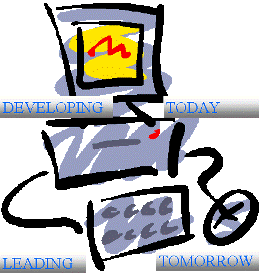XML the Basics 5
Web Oriented
XML is adopted to fit today’s Web oriented business world. According to Dahanayake and Gerhardt, the de facto standard for information exchange protocol for e-commerce is XML. Further, these authors recognize XML documents as self-describing which builds an independent platform. This provides for communications across the business world among diverse vendors and customers. This de facto standard is explained in their book.
In commerce, XML documents can be used to publish everything from product catalogs and airline schedules to stock reports and bank statements. XML forms can be used to place orders, make reservation and schedule shipments. XML eliminates the need for custom interfaces with every customer and supplier, allowing buyers to compare products across many vendors and catalog formats, and sellers to publish their catalog information once to reach many potential buyers (Dahanayake and Gerhardt, 2003, p. 67).
Besides XML being
used in the business environment, it has other applications in research,
academics, and potentially the government’s environment. For example, there is Structured Vector
Graphics (SVG) for two dimensional graphics and Mathematical Markup Language
(MathML) for mathematical equations (Morrison, 2002, p.12). Another XML language is Extensible Business
Reporting Language (XBRL) which is used for financial reporting and has the
capability to make the federal budget available for analysis over the Web. Both XBRL and Structural Product Labeling
(SPL) are emerging as open standards that will allow meaningful and unambiguous
comparisons that previously could not easily be made (Huffier,
XML the Basics 6
Components
Now that we have explored some conceptual definitions for XML and it uses, we can look at its components to better understand the language. These components are: (1) schemas, (2) document type declarations (DTD), (3) comments, and (4) entity references. The schema defines the data model and represents data types. Now incorporated into the schema is the data type declaration which describes the structure of the XML document (Huffier, Prescott, and McFadden, 2007, p. 398). Comments can be used to explain what your program is doing or what you propose to do. The comments are not part of the markup or content. An entity reference is a unique name. Certain XML data must have unique names because they represent symbols used for coding XML. For example, the less than character (<) is represented in content as the entity reference, <: (Morrison, 2002, p.281).
World Wide Web Consortium
XML schemas are readily available through the sponsor of XML, the World Wide Web Consortium (W3C). This standards organization is working to develop open standards for development of conventions for Web documents that can consistently be displayed across all platforms (Hoffer, Prescott, and McFadden, 2007, p. 396). Their schema standard defines data models and establishes data types. Thus, they provide a custom vocabulary to describe XLM documents. Since they have an open standard for open computer architecture, their hyperlink can be referenced to prescribe the XML schema. They freely provide a recommended language to define XML databases. They can be found at the hyperlink, http://www.w3.org/2001/XMLSchema (Hoffer, Prescott, and McFadden, 2007, p. 398).
Return to Web Site's Index
DELAWARE'S MIDDLETOWN ODESSA AND TOWNSEND AREA
